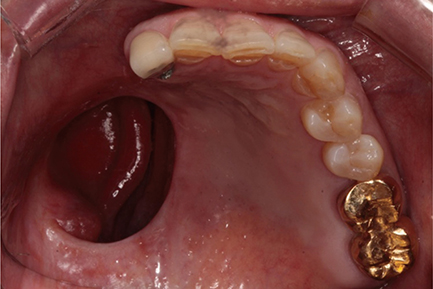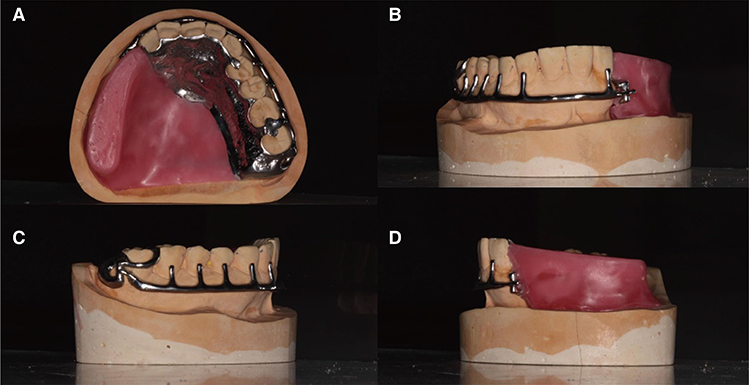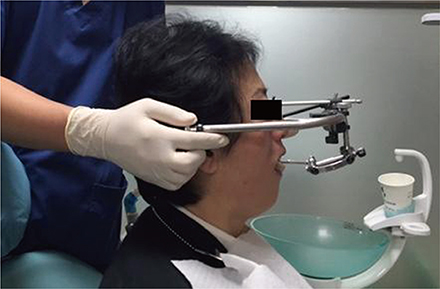J Adv Prosthodont.
2016 Oct;8(5):411-416. 10.4047/jap.2016.8.5.411.
Prosthetic reconstruction with an obturator using swing-lock attachment for a patient underwent maxillectomy: A clinical report
- Affiliations
-
- 1Department of Dentistry, Ajou University School of Medicine, Suwon, Republic of Korea. dragon_001@hanmail.net
- 2Department of Prosthodontics, Graduate School, Kyung Hee University, Seoul, Republic of Korea.
- KMID: 2355446
- DOI: http://doi.org/10.4047/jap.2016.8.5.411
Abstract
- Patients who underwent resection of maxilla due to benign or malignant tumor, or accident will have defect in palatal area. They get retention, support and stability from remaining tissues which are hardly optimal. The advantage of swing-lock attachment design is having multiple contacts on labial and lingual side of the abutment teeth by retentive strut and palatal bracing component. Because the force is distributed equally to abutment teeth, abutment teeth of poor prognosis can be benefited from it. It is also more advantageous to cover soft tissue defects which are hard to reach with conventional prosthesis. A 56-year-old female patient who had undergone a maxillectomy due to malignant melanoma complaining of loose and unstable surgical obturator. Surveyed crowns were placed on #12, 26, and 27. Teeth #11, 21, 22, and 23 had lingual rest seat and #24 had mesial rest seat to improve stability and support of the obturator. This clinical report presents the prosthetic management of a patient treated with obturator on the maxilla using swing-lock attachment to the remaining teeth.
MeSH Terms
Figure
Reference
-
1. Aramany MA. Basic principles of obturator design for partially edentulous patients. Part I: classification. J Prosthet Dent. 1978; 40:554–557.2. Myers RE, Mitchell DL. A photoelastic study of stress induced by framework design in a maxillary resection. J Prosthet Dent. 1989; 61:590–594.3. Curtis TA, Beumer J. Restoration of acquired hard palate defects: etiology, disability, and rehabilitation. In : Beumer J, Curtis TA, Marunick MT, editors. Maxillofacial rehabilitation: prosthodontic and surgical considerations. 1st ed. St. Louis: Ishiyaku Euro-America;1996. p. 225–284.4. Padilla MT, Campagni WV. The swing-lock removable partial denture. J Calif Dent Assoc. 1997; 25:387–392.5. Bolender CL, Becker CM. Swinglock removable partial dentures: where and when. J Prosthet Dent. 1981; 45:4–10.6. Schwartzman B, Caputo A, Beumer J. Occlusal force transfer by removable partial denture designs for a radical maxillectomy. J Prosthet Dent. 1985; 54:397–403.7. Ackerman AJ. The prosthetic management of oral and facial defects following cancer surgery. J Prosthet Dent. 1955; 5:413–432.8. Simmons J. Swing-lock stabilization and retention. Texas Dent J. 1963; 81:10–12.9. Javid NS, Dadmanesh J. Obturator design for hemimaxillectomy patients. J Prosthet Dent. 1976; 36:77–81.10. Black WB. Surgical obturation using a gated prosthesis. J Prosthet Dent. 1992; 68:339–342.11. Parr GR, Gardner LK. Swing-lock design considerations for obturator frameworks. J Prosthet Dent. 1995; 74:503–511.12. Lynch CD, Allen PF. The swing-lock denture: its use in conventional removable partial denture prosthodontics. Dent update. 2004; 31:506–508.13. McKenna G, Ziada H, Allen PF. Prosthodontic rehabilitation of a patient using a swing-lock lower denture after segmental mandibulectomy. Eur J Prosthodont Restor Dent. 2013; 21:141–144.14. Aggarwal H, Cho SH. Complete removable dental prosthesis with the swing lock system: A clinical report. J Prosthet Dent. 2014; 112:1035–1037.15. Razaq I, Durey K, Nattress B. Provision of a swing lock denture for a patient with Gorlin Goltz syndrome. Eur J Prosthodont Restor Dent. 2012; 20:141–144.
- Full Text Links
- Actions
-
Cited
- CITED
-
- Close
- Share
- Similar articles
-
- Implant assisted obturator in patient after maxillectomy: a case report
- Prosthetic rehabilitation of partially edentulous patient after maxillectomy: A case report
- Prosthetic rehabilitation by obturator considering the biomechanics in partially edentulous patient after maxillectomy
- Prosthetic rehabilitation of a fully edentulous patient after maxillectomy: A case report
- Prosthetic rehabilitation for a maxillectomy patient using 3D printing assisted closed hollow bulb obturator: a case report











